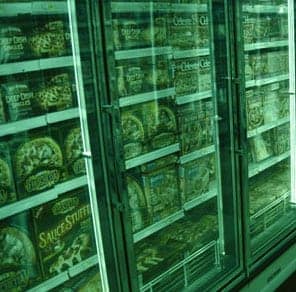A few years ago, I loved clipping coupons and following my favorite frugal blogs to score groceries as cheaply as possible. Often this meant buying processed foods for pennies on the dollar.
And then, I had several medical issues that forced me to radically change my diet to a diet high in organic vegetables, fruits, and grass-fed meats. I no longer ate processed foods or legumes (due to many food intolerances), and my grocery budget soared.
For the first year on this new eating plan, I didn’t really try to save money. After all, there are no coupons for buying meat direct from the farmer or buying a CSA share. While there are some coupons for organic produce, I was too busy making all my food from scratch to have time to clip coupons and chase deals.
But the grocery “budget” was making me downright depressed. Groceries are our highest expense behind rent.
Now that I’ve been eating this way for 18 months, I feel like I have a better handle on things and am now trying to save money again.
Now, rather than clipping coupons, I have a new strategy for saving money on groceries: computing how much each meal costs to feed my family.
How Computing The Cost Of Your Meals Saves Money

By taking the time to compute the cost of the ingredients in each standby meal, I can see that making Tuna Noodle Casserole from scratch is cheaper than making Beef Tacos from scratch. We still eat Beef Tacos, but Tuna Noodle Casserole shows up on the table a bit more than Beef Tacos.
I only figure out the price on our standby meals. If my family likes a new recipe and wants to eat it more often, I then take the time to figure out how much it costs.
A Price Book Without The Effort
I first read about keeping a price book 15 years ago when I read Amy Dacyczyn’s The Tightwad Gazette. Basically, you keep a little notebook of all the common groceries that you buy and keep track of the price. Over time, you’ll learn when the item is in a low price cycle and when it’s priced high. When it’s at its lowest price, stock up and fill the pantry. Then don’t buy the item again until the price drops to the lowest price, usually in 6 to 8 weeks.
Honestly, I hate keeping a price book. And now that we don’t buy many processed foods, I don’t see the point. However, by writing down the price for the ingredients in each recipe that we buy, I have an automatic price book without the additional effort.
One More Strategy–Pantry Friendly Meals
My other strategy is to have a few meals in my repertoire that I can make even when it’s the end of the month and we’re running low on groceries. One of those meals is Pumpkin Chili. This meal contains staples–pumpkin, tomatoes, ground beef, celery, peppers, and onion. Even if we’re running low on groceries, I usually have those ingredients available.
Having pantry favorite meals keeps me from running to the store at the last minute, especially when the grocery money is almost gone.
Although it seems time consuming, computing how much your favorite meals cost to feed your family can help you decide which meals to serve a little more often to lower your grocery bill. All without the effort of clipping coupons and running from store to store.
What’s your favorite method for saving on groceries?




When we moved to South Florida 2 years ago, I was shocked by the high grocery prices. Many items cost twice as much as they did in Texas, so I got serious about saving money at the grocery. Publix dominates the grocery market in South Florida, so the lack of competition seems to drive prices up. It’s well worth my time to shop more than 1 store, so I make weekly trips to Aldi & Costco, and then just hit Publix for the few items that are not available elsewhere. There’s no right or wrong grocery strategy – it’s a matter of what works for you, and what you have the time to do. By the way, if you hate clipping coupons…buy store brands, that alone will cut your grocery bill by 25%, and most stores will refund your money if you don’t like their brand as well as the national brand.
Excellent points. Everyone must do what is best for their particular circumstances to save money. I’m finding more and more things I can buy at Costco to save. However, Costco can be a money suck if you don’t stick to a grocery list. Some people find it too tempting.
Thanks for your “pricing each meal” idea. That would give far more variety to meal planning than my current method. (Cheapest ingredients in various configurations.)
Kristl from Florida made me think of something. Different regions suggest different strategies. When we lived in South Dakota we joined a food coop and often split things like 50 pound bags of whole wheat flour or oats with other members. Meat was really cheap. When we lived in Wisconsin cheese and dairy were cheap but there was only one grocery store anywhere near us, so couponing/shopping sales was king. Since moving back to Pennsylvania we’ve put in a small garden, frequent a local salvage grocer, and visit a farmer who sells inexpensive eggs. There is no local food coop, but we have been able to keep costs in check.
The price book you mentioned worked well right after our move here as we were getting a feel for area store prices. Because of the price book, I found the Sam’s Club prices didn’t match local sale or with doubled coupon prices. So the membership and travel costs weren’t worth it. One mega grocer in town actually had higher prices generally than the small family run chain. But occasionally they do triple coupons or have good sales. Now I work with price thresholds. Pay no more than this for cheese, no more than this for apples, etc.
Cooking from scratch is by far the biggest money saver. Brand flexibility is another.
I try to use every bit of everything I buy. One example: I stock up on bone-in chicken thighs at their lowest price, debone them, and make chicken stock with bones, along with all the vegetable ends I accumulate in big freezer bag. I don’t buy high-priced, specialty ingredients anymore that won’t get used up; if I can’t find a cheaper alternative (like Worcestershire sauce instead of anchovy paste), I leave it out or find another recipe. I use DIY ingredients: make my own bread crumbs; grate, grind, and shred my own cheese; etc. And a weekly leftover buffet has become an accepted tradition. When I do weekly meal planning, I take a freezer and pantry inventory so everything gets used and I don’t over-buy. Now, I’m instituting portion control: I serve up plates in the kitchen based on the number of servings I expect to get from a recipe. If folks are still hungry, they are free to get a second helping, but we start out with a smaller amount. We go to these lengths to save money (I’ve reduced spending on food by about $2,000 a year), but also to reduce food waste on ethical grounds. Americans waste one third of the food produced in US. That’s 133 billion pounds of food sent to the dump each year. That’s 141 trillion calories wasted in a world where 870 million people are undernourished. Disposing of all this wasted food costs cities $1.3 billion that could be used for other purposes. And it makes A LOT of methane gas, which changes our climate.
I don’t really have method for saving money on groceries. My goal is to stop eating on the run so often.
Thanks for this post. I use to hate clipping coupons for groceries. Even now I sometimes for get about them. We do have a store here that made it easier by doing electronic coupons and rewards so that is cool. Great tips here as well. Thanks.
Great tips! I was wondering if you’d be willing to share your recipe for “Pumpkin Chili. This meal contains staples–pumpkin, tomatoes, ground beef, celery, peppers, and onion.”
I am particularly fond of pumpkin but had never thought to use it in chili.
My big goal to save money is to try not to spend over $2/pound on meats. This is getting increasingly difficult though so have gone up some on the price I am willing to pay.